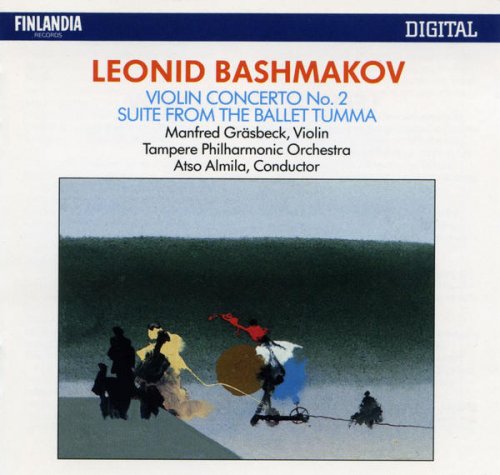Manfred Grasbeck, Atso Almila, Tapani Farding - Leonid Bashmakov: Violin Concerto No. 2, Suite From The Ballet "Tumma" (1990)

Artist: Manfred Grasbeck, Atso Almila, Tapani Farding
Title: Leonid Bashmakov: Violin Concerto No. 2, Suite From The Ballet "Tumma"
Year Of Release: 1990
Label: Finlandia Records
Genre: Classical
Quality: FLAC (tracks+.cue,log,scans)
Total Time: 01:03:48
Total Size: 265 Mb
WebSite: Album Preview
Tracklist: Title: Leonid Bashmakov: Violin Concerto No. 2, Suite From The Ballet "Tumma"
Year Of Release: 1990
Label: Finlandia Records
Genre: Classical
Quality: FLAC (tracks+.cue,log,scans)
Total Time: 01:03:48
Total Size: 265 Mb
WebSite: Album Preview
1. Violin Concerto No. 2 (1985)
2. Suite From The Ballet "Tumma" (1976)
Performers:
Composed By – Leonid Bashmakov
Conductor – Atso Almila
Orchestra – Tampere Philharmonic Orchestra
Timpani – Tapani Färding
Violin – Manfred Gräsbeck (tracks: 1)
Leonid Bashmakov (b.1927) is a Finnish composer (born in South Karelia, which is nowadays located in Russia) and - together with Rautavaara, Meriläinen, and Heininen - a pupil of Aarre Merikanto (a still underrated composer). Those pupils have relatively little in common stylistically (a testament to Merikanto undogmatic teaching, presumably), though Bashmakov is in at least some ways the one whose music is closest to his teacher at least in how it immediately sounds. Bashmakov's music is expressive, free-tonal and rooted in neo-classicism, filtered through dodecaphonic methods and techniques. The result is an extremely colorful, energetic and often exhilarating tonal language that is, in fact, somewhat reminiscent of Honegger. It should scare off no one who can stand the moderate modernism of, say, Honegger or Jolivet, but is original enough to appeal to those who require a personal voice.
The second violin concerto dates from 1985 (with Manfred Gräsbeck, who also plays it here, giving the premiere). It is a colorful and often strangely atmospheric work with plenty of magic and mystery, and ample opportunity for vivid pattern drawings from the soloist. It has an overall improvisatory quality with plenty of experimental parts (and even aleatoric techniques), and is overall quite compelling - not a groundbreaking work, perhaps, but excellent enough to deserve concentrated listening.
The music from the ballet Tumma is somewhat lighter fare, with snippets of melodies, lush textures and plenty of drive and drama. It is brilliantly and resourcefully scored with plenty of mysterious colors and plays with light and shade, symbolism, lyrical reflection, menace and beauty. It is performed with verve and spirit by the Tampere Philharmonic Orchestra (the demanding timpani solos that bridge the movements are skillfully handled by Topani Färding), and Gräsbeck is an impressive soloist in the concerto. The sound is also good, and overall this is a very recommendable release of some fascinating music. There is one major drawback, however: why on earth does Finlandia allot a single track (24 minutes) to the concerto and a single track (40 minutes) to the ballet? It a is pretty annoying detail, especially as the booklet talks about the individual movements of both the concerto and the ballet (and they are obviously separated by the composer and performers).
The second violin concerto dates from 1985 (with Manfred Gräsbeck, who also plays it here, giving the premiere). It is a colorful and often strangely atmospheric work with plenty of magic and mystery, and ample opportunity for vivid pattern drawings from the soloist. It has an overall improvisatory quality with plenty of experimental parts (and even aleatoric techniques), and is overall quite compelling - not a groundbreaking work, perhaps, but excellent enough to deserve concentrated listening.
The music from the ballet Tumma is somewhat lighter fare, with snippets of melodies, lush textures and plenty of drive and drama. It is brilliantly and resourcefully scored with plenty of mysterious colors and plays with light and shade, symbolism, lyrical reflection, menace and beauty. It is performed with verve and spirit by the Tampere Philharmonic Orchestra (the demanding timpani solos that bridge the movements are skillfully handled by Topani Färding), and Gräsbeck is an impressive soloist in the concerto. The sound is also good, and overall this is a very recommendable release of some fascinating music. There is one major drawback, however: why on earth does Finlandia allot a single track (24 minutes) to the concerto and a single track (40 minutes) to the ballet? It a is pretty annoying detail, especially as the booklet talks about the individual movements of both the concerto and the ballet (and they are obviously separated by the composer and performers).
![Diamanda Galas - You Must Be Certain Of The Devil (2025 Remaster) (2025) [Hi-Res] Diamanda Galas - You Must Be Certain Of The Devil (2025 Remaster) (2025) [Hi-Res]](https://img.israbox.com/img/2025-11/01/hmvao132qf78re7n2ht1zg3ro.jpg)





![Steve Dyer - Multipolar (2025) [Hi-Res] Steve Dyer - Multipolar (2025) [Hi-Res]](https://www.dibpic.com/uploads/posts/2025-10/1761825501_ytogdzj35kbcb_600.jpg)
![Mister Water Wet - Things Gone and Things Here Still (2025) [Hi-Res] Mister Water Wet - Things Gone and Things Here Still (2025) [Hi-Res]](https://img.israbox.com/img/2025-11/01/wx3gsgl9rdpwqmeprfu0iyafl.jpg)
